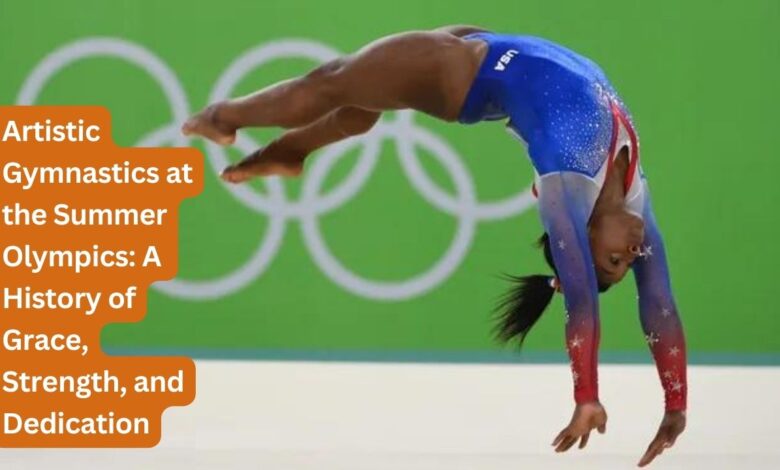Artistic Gymnastics at the Summer Olympics: A History of Grace, Strength, and Dedication

Artistic gymnastics at the Summer Olympics is one of the most captivating and highly anticipated events in the world of sports. Combining grace, strength, and dedication, this discipline showcases the peak of human athleticism and artistry. From its early beginnings to the modern-day spectacle, artistic gymnastics has evolved significantly, producing some of the most memorable moments in Olympic history.
The Origins and Evolution of Artistic Gymnastics
Early Beginnings
The origins of artistic gymnastics can be traced back to ancient Greece, where physical fitness and agility were highly valued. However, the modern sport began to take shape in the 19th century with the establishment of gymnastics clubs in Europe. The first major international competition, the World Championships, was held in 1903.
Introduction to the Olympics
Artistic gymnastics made its debut at the inaugural modern Olympic Games in Athens in 1896. Initially, the competition was open only to men and included events such as horizontal bar, parallel bars, vault, and pommel horse. Women’s artistic gymnastics was introduced at the 1928 Amsterdam Games, featuring events like the team competition, balance beam, uneven bars, and floor exercise.
Structure and Events of Artistic Gymnastics
Men’s Events
Men’s artistic gymnastics at the Summer Olympics comprises six events:
- Floor Exercise: Gymnasts perform a series of acrobatic and dance elements on a 12×12 meter mat.
- Pommel Horse: Athletes execute circular movements and swings on a padded horse with handles.
- Still Rings: Gymnasts perform strength and balance elements on two suspended rings.
- Vault: Athletes sprint towards a vaulting table, performing flips and twists in the air before landing.
- Parallel Bars: Gymnasts perform swings, balances, and releases on two parallel bars.
- Horizontal Bar: Athletes execute swings and releases on a single horizontal bar.
Women’s Events
Women’s artistic gymnastics includes four events:
- Vault: Similar to the men’s event, athletes perform flips and twists over a vaulting table.
- Uneven Bars: Gymnasts swing between two bars set at different heights, performing releases and transitions.
- Balance Beam: Athletes perform acrobatic and dance elements on a narrow beam.
- Floor Exercise: Gymnasts perform a choreographed routine to music on a 12×12 meter mat.
Scoring and Judging
The Code of Points
Artistic gymnastics is judged based on the Code of Points, which evaluates routines on two main components:
- Difficulty Score (D-score): This score reflects the difficulty of the elements performed in a routine. Each element has a predetermined value based on its complexity and risk.
- Execution Score (E-score): This score assesses the performance’s execution, artistry, and form. Deductions are made for errors such as falls, poor technique, and lack of synchronization with the music (for floor exercises).
The final score is the sum of the D-score and E-score, minus any deductions for time violations or other infractions.
Iconic Moments and Legendary Gymnasts
Nadia Comăneci’s Perfect 10
One of the most iconic moments in Olympic history occurred at the 1976 Montreal Games when Romanian gymnast Nadia Comăneci scored the first perfect 10 in Olympic gymnastics history. Her flawless routine on the uneven bars stunned the world and set a new standard for excellence in the sport.
Simone Biles’ Dominance
Simone Biles, an American gymnast, has redefined the boundaries of artistic gymnastics with her extraordinary skills and unprecedented achievements. At the 2016 Rio Olympics, Biles won four gold medals and one bronze, showcasing her dominance and solidifying her status as one of the greatest gymnasts of all time.
Vitaly Scherbo’s Record-Breaking Feat
At the 1992 Barcelona Games, Belarusian gymnast Vitaly Scherbo made history by winning six gold medals in a single Olympics. His remarkable achievement remains unmatched and highlights the incredible talent and determination required to excel in artistic gymnastics.
The Impact of Artistic Gymnastics on the Olympics
Popularity and Global Reach
Artistic gymnastics is one of the most popular events at the Summer Olympics, attracting millions of viewers worldwide. The sport’s combination of athleticism, artistry, and high-flying acrobatics captivates audiences and inspires future generations of gymnasts.
Technological Advancements and Training
Advancements in technology and training methods have significantly impacted artistic gymnastics. Modern equipment, such as spring floors and advanced vaulting tables, allows gymnasts to perform more complex and higher-risk elements. Additionally, enhanced training techniques, including video analysis and biomechanical assessments, help athletes optimize their performance and reduce the risk of injury.
Challenges and Controversies
Scoring Disputes
Artistic gymnastics has faced its share of scoring controversies, with disputes often arising over the subjective nature of judging. High-profile incidents, such as the 2004 Athens Olympics vault controversy involving South Korean gymnast Yang Tae-young, have highlighted the need for transparency and consistency in scoring.
Pressure and Mental Health
The intense pressure and demands of competitive gymnastics can take a toll on athletes’ mental health. Gymnasts like Simone Biles and Laurie Hernandez have spoken openly about the importance of mental well-being and the challenges of balancing the pressures of competition with personal health.
The Future of Artistic Gymnastics
Emerging Talents
The future of artistic gymnastics looks promising, with emerging talents from around the world poised to make their mark on the sport. Young gymnasts like Sunisa Lee of the United States and Nikita Nagornyy of Russia are already showing potential to become the next generation of Olympic champions.
Evolution of the Sport
As artistic gymnastics continues to evolve, we can expect to see new elements and innovations that push the boundaries of what is possible. The sport’s governing bodies are continually updating the Code of Points to reflect these advancements and ensure the continued growth and excitement of artistic gymnastics at the Summer Olympics.
Conclusion
Artistic gymnastics at the Summer Olympics is a celebration of human potential, combining grace, strength, and dedication in a display of extraordinary athleticism. From its origins to its current status as one of the premier Olympic events, artistic gymnastics has captivated audiences and inspired countless athletes. As we look to the future, the sport will undoubtedly continue to evolve, producing new legends and unforgettable moments on the Olympic stage.




